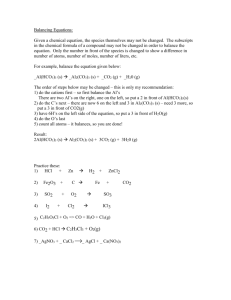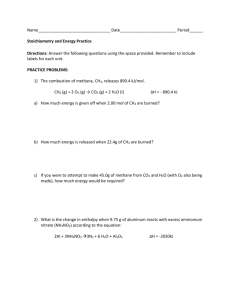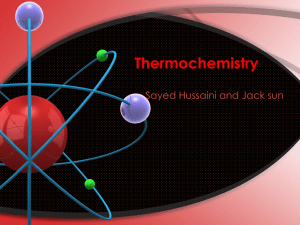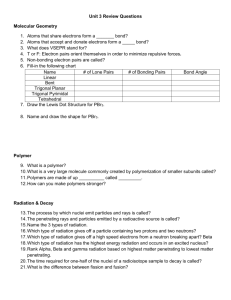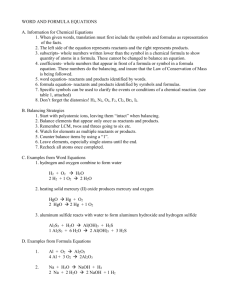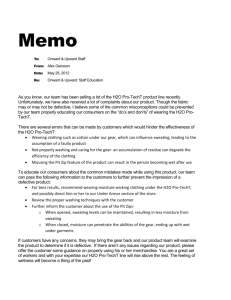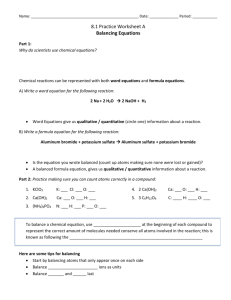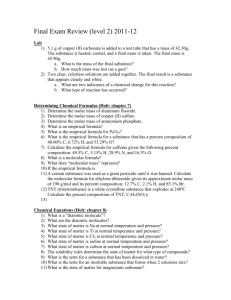Hess`s Law
advertisement
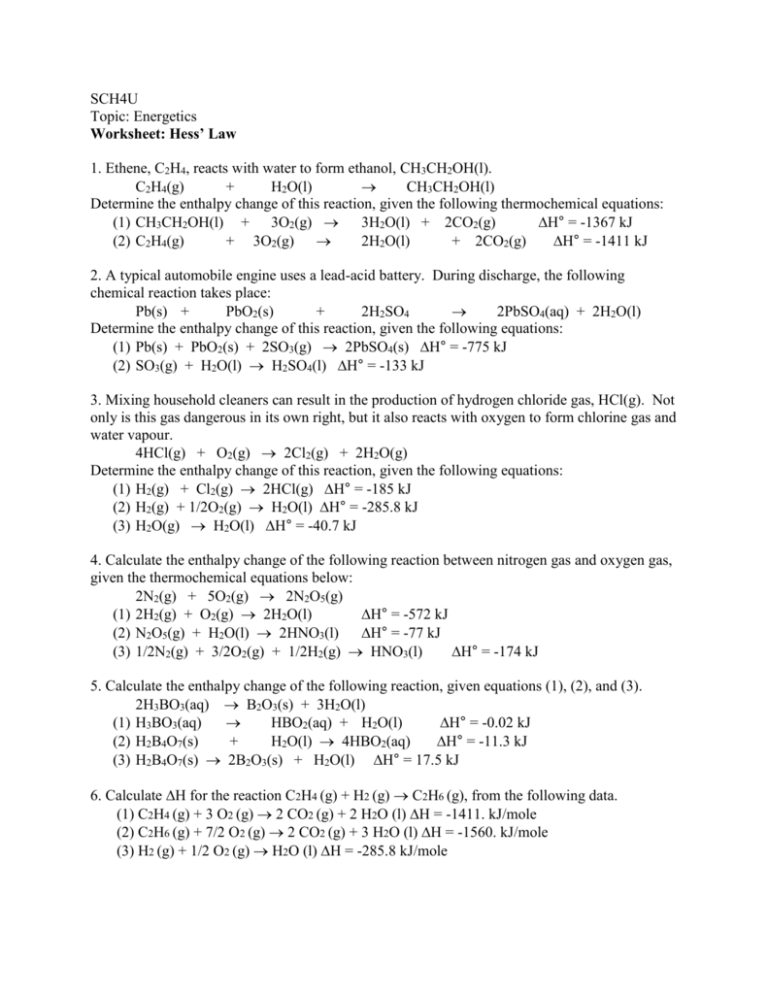
SCH4U Topic: Energetics Worksheet: Hess’ Law 1. Ethene, C2H4, reacts with water to form ethanol, CH3CH2OH(l). C2H4(g) + H2O(l) CH3CH2OH(l) Determine the enthalpy change of this reaction, given the following thermochemical equations: (1) CH3CH2OH(l) + 3O2(g) 3H2O(l) + 2CO2(g) H° = -1367 kJ (2) C2H4(g) + 3O2(g) 2H2O(l) + 2CO2(g) H° = -1411 kJ 2. A typical automobile engine uses a lead-acid battery. During discharge, the following chemical reaction takes place: Pb(s) + PbO2(s) + 2H2SO4 2PbSO4(aq) + 2H2O(l) Determine the enthalpy change of this reaction, given the following equations: (1) Pb(s) + PbO2(s) + 2SO3(g) 2PbSO4(s) H° = -775 kJ (2) SO3(g) + H2O(l) H2SO4(l) H° = -133 kJ 3. Mixing household cleaners can result in the production of hydrogen chloride gas, HCl(g). Not only is this gas dangerous in its own right, but it also reacts with oxygen to form chlorine gas and water vapour. 4HCl(g) + O2(g) 2Cl2(g) + 2H2O(g) Determine the enthalpy change of this reaction, given the following equations: (1) H2(g) + Cl2(g) 2HCl(g) H° = -185 kJ (2) H2(g) + 1/2O2(g) H2O(l) H° = -285.8 kJ (3) H2O(g) H2O(l) H° = -40.7 kJ 4. Calculate the enthalpy change of the following reaction between nitrogen gas and oxygen gas, given the thermochemical equations below: 2N2(g) + 5O2(g) 2N2O5(g) (1) 2H2(g) + O2(g) 2H2O(l) H° = -572 kJ (2) N2O5(g) + H2O(l) 2HNO3(l) H° = -77 kJ (3) 1/2N2(g) + 3/2O2(g) + 1/2H2(g) HNO3(l) H° = -174 kJ 5. Calculate the enthalpy change of the following reaction, given equations (1), (2), and (3). 2H3BO3(aq) B2O3(s) + 3H2O(l) (1) H3BO3(aq) HBO2(aq) + H2O(l) H° = -0.02 kJ (2) H2B4O7(s) + H2O(l) 4HBO2(aq) H° = -11.3 kJ (3) H2B4O7(s) 2B2O3(s) + H2O(l) H° = 17.5 kJ 6. Calculate H for the reaction C2H4 (g) + H2 (g) C2H6 (g), from the following data. (1) C2H4 (g) + 3 O2 (g) 2 CO2 (g) + 2 H2O (l) H = -1411. kJ/mole (2) C2H6 (g) + 7/2 O2 (g) 2 CO2 (g) + 3 H2O (l) H = -1560. kJ/mole (3) H2 (g) + 1/2 O2 (g) H2O (l) H = -285.8 kJ/mole 7. Calculate H for the reaction 4 NH3 (g) + 5 O2 (g) 4 NO (g) + 6 H2O (g), from the following data. (1) N2 (g) + O2 (g) 2 NO (g) H = -180.5 kJ (2) N2 (g) + 3 H2 (g) 2 NH3 (g) H = -91.8 kJ (3) 2 H2 (g) + O2 (g) 2 H2O (g) H = -483.6 kJ 8. Find Hf for acetic acid, HC2H3O2, using the following thermochemical data. (1) HC2H3O2 (l) + 2 O2 (g) 2 CO2 (g) + 2 H2O (l) H = -875. kJ/mole (2) C (s, graphite) + O2 (g) CO2 (g) H = -394.51 kJ/mole (3) H2 (g) + 1/2 O2 (g) H2O (l) H = -285.8 kJ/mole 9. Calculate H for the reaction CH4 (g) + NH3 (g) HCN (g) + 3 H2 (g), from the reactions. (1) N2 (g) + 3 H2 (g) 2 NH3 (g) H = -91.8 kJ (2) C (s, graphite) + 2 H2 (g) CH4 (g) H = -74.9 kJ/mole (3) H2 (g) + 2 C (s, graphite) + N2 (g) 2 HCN (g) H = +270.3 kJ 10. Calculatefor the reaction 2 Al (s) + 3 Cl2 (g) 2 AlCl3 (s) from the following data. (1) 2 Al (s) + 6 HCl (aq) 2 AlCl3 (aq) + 3 H2 (g) H = -1049. kJ (2) HCl (g) HCl (aq) H = -74.8 kJ/mole (3) H2 (g) + Cl2 (g) 2 HCl (g) H = -1845. kJ (4) AlCl3 (s) AlCl3 (aq) H = -323. kJ/mole 11. One reaction involved in the conversion of iron ore to the metal is FeO (s) CO (g) Fe (s) CO2 (g) Calculate the standard enthalpy change for this reaction from these reactions of iron oxides with CO : (1) 3 Fe2O3 (s) CO (g) 2 Fe3O4 (s) CO2 (g) H - 47.0 kJ (2) Fe2O3 (s) 3 CO (g) 2 Fe (s) 3 CO2 (g) H - 25.0 kJ (3) Fe3O4 (s) CO (g) 3 FeO (s) CO2 (g) H 19.0 kJ 12. The combination of coke and steam produces a mixture called coal gas, which can be used as a fuel or as a starting material for other reactions. If we assume coke can be represented by graphite, the equation for the production of coal gas is 2 C (s) 2 H2O (g) CH4 (g) CO2(g) Determine the standard enthalpy change for this reaction from the following standard enthalpies of reaction : (1) C(s) H2O (g) CO (g) H2 (g) H 131.3 kJ (2) CO (g) H2O (g) CO2 (g) H2 (g) H - 41.2 kJ (3) CH4 (g) H2O (g) 3 H2 (g) CO (g) H 206.1 kJ 13. Carbon tetrachloride, CCl4, an organic solvent is prepared by the reaction of chlorine gas, Cl2, with CS2. Using Hess’ Law, determine the heat of reaction (H) for the reaction: CS2 (l) + 3 Cl2 (g) CCl4 (l) + S2Cl2 (l) given these data: i. CS2 (l) + 3 O2 (g) CO2 (g) + 2 SO2 (g) H = -1077 kJ ii. S (s) + ½ Cl2 (g) ½ S2Cl2 (l) H = -30.1 kJ iii. C (gr) + 2 Cl2 (g) CCl4 (l) H = -135.4 kJ iv. S (s) + O2 (g) SO2 (g) H = -296.9 kJ v. C (gr) + O2 (g) CO2 (g) H = -393.5 kJ 14. Find the heat of formation of C2H6 (g) from the following data: 2 C2H6 (g) + 7 O2 (g) 4 CO2 (g) + 6 H2O (l) H = -3120 kJ C (gr) + O2 (g) CO2 (g) H = -394 kJ H2 (g) + ½ O2 (g) H2O (g) H = -242 kJ H2O (l) H2O (g) H = 44 kJ 15. Given the following data: H2 (g) + ½O2 (g) H2O (l) N2O5 (g) + H2O (l) 2HNO3 (l) ½N2 (g) + 3/2O2 (g) + 1/2H2 (g) HNO3 (l) Calculate H for the reaction: 2N2 (g) + 5O2 (g) 2N2O5 (g) 16. Given the following data 2O3 (g) 3O2 (g) O2 (g) 2O (g) NO (g)+O3 (g)NO2 (g) + O2 (g) Calculate H for the reaction NO (g) + O (g) NO2 (g) H = -285.8 kJ H = -76.6 kJ H = -174.1 kJ H = -427 kJ H = +495 kJ H = -199 kJ


